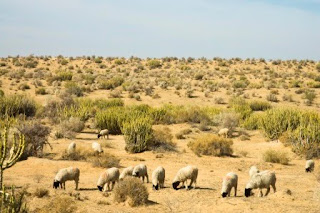Unlängst habe ich Indien bereist. Ein sehr farbenfrohes Land. Ich sah Flüsse, die so intensiv blau oder grün waren, oder rosa oder lila oder orange, je nachdem, welche Farben die T-Shirts hatten, die in den Fabriken an den Ufern dieser Flüsse gerade produziert wurden. Und ich sah die ebenholzschwarzen Baumleichen und schimmernd fezesbraunen Moderpflanzen und intensiv moosgrünen Verwesungsgewächse dort, wo einmal Auen waren, die sonnengelben und himmelblauen Plastiktüten und goldenen und silbernen Aludosen, die glänzenden elfenbein- oder anthrazitfarbenen und grell- oder hellroten Teile von Haushaltsgeräten oder Autokarrosserien, die in diesem Farbenwunderland schwammen - ich sah, dass der Tod farbenfroh ist. Der Tod. Er sichert in Indien das Überleben menschlicher Zombies: ich erfuhr, dass die Menschen in diesen Fabriken umgerechnet € 1,50.- für einen zehnstündigen Arbeitstag bekommen. Und ich sah die Slums, in die diese Menschen dann nach der Arbeit zurückkehren, ein Hüttengewucher ohne Elektrizität und ohne Kanalisation. Der Tod. Er sichert das reiche Leben jener, mit denen »wir«, das heißt unsere politischen Repräsentanten, unsere Vorstellungen von der Gestaltung der Welt austauschen.
Auf dem Rückflug bekam ich deutsche Zeitungen. Und ich las, dass in Europa »die Arbeit zu teuer« sei, die Lohnkosten einen »Wettbewerbsnachteil« darstellten. Das haben Sie alle auch gelesen. Immer wieder, es steht ja täglich in den Tageszeitungen, darum heißen Sie ja Tageszeitungen. Und Sie haben dazu genickt. Zumindest habe ich Ihren Protest, Ihr Nein nicht gehört. Sie haben genickt und sich gedacht: ja, die Zeiten werden härter, es stimmt schon, da müssen wir etwas tun, um wettbewerbsfähig zu bleiben oder zu werden, wir müssen Abstriche machen, härter werden, fitter sein. Haben Sie sich einmal gefragt, wie weit man in Europa die Lohnkosten senken kann, ohne dass ein Bürgerkrieg ausbricht? Ohne dass dieser Kontinent zurückfällt in eine Situation, von der es in europäischen Sonntagsreden heißt, dass sie nie wieder - und so weiter? Man kann die Lohnkosten und Sozialleistungen hier vielleicht noch einige Prozentpunkte senken, aber sicherlich nicht auf € 1,50 für einen zehnstündigen Arbeitstag! Haben Sie sich schon einmal klar gemacht, dass diesen sogenannten Wettbewerb die europäische

































































